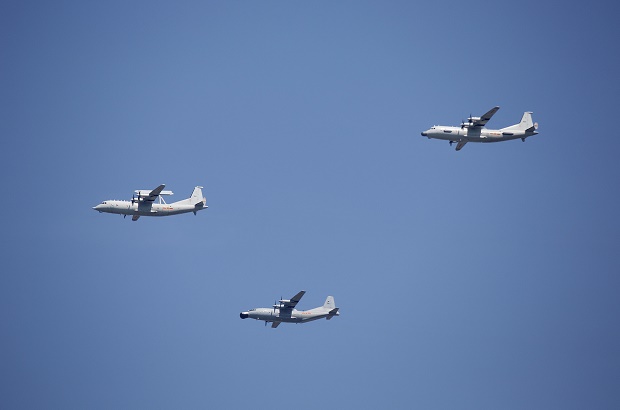Pentagon says US, Chinese air encounter unintentional

In this Sept. 3, 2015 file photo, a KJ-200 airborne early warning and control plane, left, a Y-8J radar plane, center, and a Y-9JB radar plane, right, fly in formation during a parade commemorating the 70th anniversary of Japan’s surrender during World War II in Beijing. The U.S. Pacific Command says a Chinese aircraft and a U.S. Navy patrol plane had an “unsafe” encounter over the South China Sea this week, raising concerns. Pacific Command spokesman Robert Shuford said Friday, Feb. 10, 2017, that the “interaction” between a Chinese KJ-200 early warning aircraft and a U.S. Navy P-3C plane took place on Wednesday, Feb. 8, in international airspace over the waters. AP FILE PHOTO
BEIJING — The Pentagon said a close encounter between a Chinese early warning aircraft and a US Navy patrol plane over the South China Sea appeared to be unintentional and both pilots maintained professional radio contact, in the first such incident known to have taken place under President Donald Trump’s administration.
A Chinese KJ-200 flew within 1,000 feet (305 meters) of a US Navy P-3C in international airspace over Scarborough Shoal near the Philippines on Wednesday, Pentagon spokesman Capt. Jeff Davis told reporters in Washington.
He said the Chinese aircraft “crossed the nose” of the P-3, forcing it to make an immediate turn.
“We don’t see any evidence that it was intentional,” he said, adding that the incident was a “one-off.” He said both pilots were in “normal radio contact” and their communication “professional.”
The Chinese Defense Ministry did not immediately respond to a faxed request for comment.
However, the website of the Communist Party newspaper Global Times quoted an unidentified ministry official as saying that the Chinese pilot had responded in a “legal and professional manner.”
“We hope the US side will focus on the relationship between the two countries and two militaries in their entirety, adopt concrete measures and eliminate the root causes of accidental incidents between the two countries on sea and in the air,” the unidentified official was quoted as saying.
Philippine Defense Department spokesman Arsenio Andolong also expressed concern because the incident happened near Scarborough Shoal, which is located within the Philippines’ 200-mile exclusive economic zone but claimed by China, which seized it in 2012 after a tense standoff with Philippine vessels.
“We’re worried of possible miscalculation and it’s good to know that nothing untoward happened,” Andolong said by telephone. If such foreign aircraft venture into Philippine airspace, “we deserved to be told out of courtesy.”
Such incidents have occurred occasionally over and within the South China Sea, which China claims virtually in its entirety. Although China says it respects freedom of navigation in the strategically vital area, it objects to US military activities, especially the collection of signals intelligence by US craft operating near the coast of its southern island province of Hainan, home to several military installations.
In recent years, the sides have signed a pair of agreements aimed at preventing such encounters from sparking an international crisis, as happened in April 2001 when a Chinese jet fighter collided with a US surveillance plane over the South China Sea, leading to the death of the Chinese pilot and China’s detention of the 24 US crew members for 10 days.
RELATED STORIES